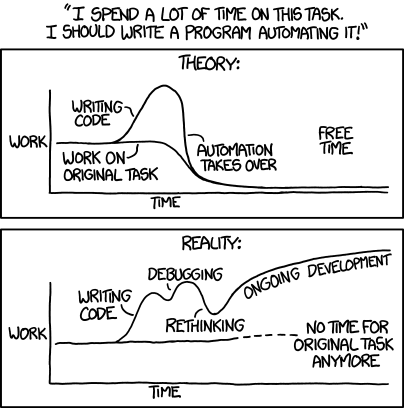How to select a process for Automation
Is Process “X” Suitable for Automation?
What are the criteria or factors that can be used for the decision?
When you start considering automation, the first challenge to is to identify candidate processes that are suitable for automation.
The challenge is knowing which processes are the right ones to automate.
INTRODUCTION
One approach, could be to discover the processes that have been automated by similar businesses or competitors. This might be difficult to achieve as businesses do not publish such information.
A second approach would be to look at the case studies published by automation software vendors. These contain some broad indications of the processes which have been automated.
Both these approaches can provide some guidance, but they will raise the question of whether the processes in your business are actually the same as in other companies.
A third approach could be to engage a Process Consultant to review and document all your processes, asking them to recommend where automation would be appropriate.
Any investment in reviewing and documenting processes will delivers its own benefits. However, it is rare for a “Process” expert to also be an “Automation” expert. They will rely on experience, checklists and other criteria to identify the processes.
With access to checklists and guidance on the factors, would you be able to select suitable processes? Yes, of course you would. This could be the fourth approach.
A fifth approach would be to use data to provide evidence of processing activity that is suitable for automation. There are some sophisticated “Process Mining” tools available that are used to deliver that information. Once purchased and installed, they monitor the activity of many users in an environment and look for patterns in the data.
This page aims to provide some knowledge to perform your own candidate process analysis in respect of selection for automation.
OPTIONS FOR AN AUTOMATION SOLUTION
It may seem unusual to think about the solutions before the selection criteria, but the solutions can give the context about how to interpret the selection factors.
What would an automation solution look like?
One option will be to amend the computer applications so that they more closely fit the business activity. If the applications are custom built that might be achievable but if they are a package / SaaS facility from a major vendor like Microsoft, Oracle, SAP, Salesforce, Workday, any custom change will be difficult to create.
A second option is the development of a new custom application to deliver the enhanced business functionality and utilise the published API’s to interact with existing computer applications. This approach will ultimately deliver the most efficient processing but is costly to develop and takes considerable elapsed time as with any IT development.
The third option is RPA (Robotic Process Automation). This uses software robots to perform the tasks that people undertake on computer application. By simulating the actions of users, reading from the screen, typing on the keyboard as well as clicking the mouse. By using the existing user interface, there is no change to the computer applications and hence no new risk.
Creating a software robot is relatively quick and once created it can easily be replicated to deliver additional processing capacity that can be switched on or off, as required to meet the levels of workload.
The debate of RPA versus API (Application Program Interface) is often raised when reviewing options. Most RPA technology can use APIs, which is a variation on a bespoke development.
In considering solutions, it is worth recognising that Automation does not always have to be for a complete process in order to be successful. A mix of human actions and automation can deliver the best of both capabilities.
OVERALL SELECTION CONSIDERATIONS
There is no one factor which determines suitability.
Generally, automation will only be implemented where it offers a cost effective solution, but there can be exceptions. For example, one manager required a process to be automated as the current activity meant he was working in the office during the early evening. For him, the automation enabled him to get the work done while he was getting home for precious family time.
The selection factors have been grouped into:
- Quantitative
- Quality
- People
There is no implied order of importance and no weighting between the groups.
QUANTITATIVE SELECTION FACTORS
Does the process only use digital data as input and only produce digital data as output?
Automation of tasks performed by people that are not completed by using a computer would require some form of physical robot or machine. Such automations are generally outside the scope of this article.
Are all the decisions based on rules / criteria using data?
Programming logic can be used to implement such decisions in any automation. If judgement is involved in the decision making during a process, then Artificial Intelligence (AI) could be deployed to implement the decisions based on previous patterns extracted from existing cases.
Do any decisions require subjectivity / emotion?
The need for any such decisions indicates that Artificial Intelligence (AI) would be required in any automation, but it is probable that these type of decisions will continue to require human actions.
Are more than 2 computer applications involved?
In a process where only one application is used, it is likely that a change to that system would be appropriate rather than the creation of an automation.
How many computer screens / windows could be seen in the process?
The greater the number of screens, the more complex the task. Understanding this number is also going to account for the variations in the processing.
How many data files are used in the process?
The greater the volume of activity the larger the potential benefit from automation. Similarly, if there are many different categories or types of file, it indicates a more complex the process which will deliver a larger benefit from automation.
How many data items are involved in the process?
This number should include all data items that are “Checked”, “Entered”, “Amended”, or “Sent”. The larger the number, the more complex the process and the greater chance of human error occurring.
How many staff perform the process?
This provides a measure of how many staff know about the process and an indication of how many could benefit from any automation.
How many times a day / month Is the process performed?
This number provides an indication of much benefit will be gained from the automation of the process. Additional points to consider are any seasonal variations, any monthly or quarterly peaks in activity. Where peaks do occur, any automation will take pressure of staff who would normally be involved in performing the process.
Could the process be undertaken overnight or at weekends?
For most businesses, staff perform processes during a working day. If a process is automated, there is the potential to alter when the process is executed as robots can work 24 x 7. There could be a dependency on the availability of information for any option to consider the adjustment in the time when a process is executed.
If a process is currently undertaken overnight or weekends, what is the constraint driving this time?
With robots able to execute work more quickly than people and at a lower cost, there might be the potential to automate the process so that any human activity involved with handling exceptions could be undertaken in the main working day.
Is the process currently outsourced?
If the process execution currently occurs with staff who do not have a detailed knowledge of the business but follow the defined process according to guidelines and documentation; it is likely that the activity could be automated.
Do instances of the process ever get paused?
By understanding if pauses are ever used, it can indicate that the automation may need a similar ability. Considerations about process re-start or process cancellation will add to the complexity of any automated solution.
Is it important who completes the process?
Understanding if any of the staff could complete the execution of a process will indicate if any extra knowledge or skill is required and hence the complexity for any automation. Once a person starts a process do they have to complete it to the end, or is it possible for another member of staff to pick-up partly completed processes and continue their execution.
Are there management reports on the state of the process?
The existence of management reports indicates that a process is important to the business and the data in any such reports will identify potential variations or complexities in the process.
Are the processes subject to Audit reviews and External Compliance checks?
Processes that rely on humans to maintain accurate records of actions are always prone to human errors. Automation will deliver consistency to the records and so improve any future reviews or checks.
Are Legacy applications used in the process?
For technical and commercial reasons, most businesses are reluctant to invest in or change legacy applications. As automation can be deployed in a “Non-intrusive” style, it can provide a means of continued use of legacy systems without increasing technical risk.
How many variations are there in the process?
The more variations either in the detail of the tasks required to perform the process or in the outcomes from the process, the more complex the process and therefore the more effort it will take to automate the activity.
Does the process involve any data matching or comparisons?
The human skill required to verify consistency of data and identify any differences is stronger in some individuals than others. It is a challenge for a person is to be able to execute the skill repeatedly with accuracy. If the number of instances where there is a difference is low, a person’s concentration will be tested and the number of missed differences can be high. Automation is particularly good at making such comparisons and is ideal for any “Needle in a haystack” work.
Is there more than one trigger for the process?
The greater the number of events that can trigger a process to execute, the more work that will be required to build the automation to detect the events.
Could the process be divided into discrete tasks which could be executed separately?
When processes can be detailed as a collection of tasks, which can be performed separately then there is more scope to alter when and who does each task. The greater the flexibility, the greater the opportunity to consider automation.
QUALITY FACTORS
Is the process documented?
When a process has been documented, the tasks involved will have been identified. Hopefully, any exceptions will be known about. The information means that should be easier to accurately consider the process for automation.
Is the cost of errors in the processing high?
The costs may come in the form of effort to rectify, damage to reputation, compliance assessments, etc. Automation will deliver consistency which by definition removes human errors.
Is it tedious to perform the process?
People find it difficult to keep attention when tasks are tedious. They become easily distracted, taking longer to complete the activity and the number of errors tends to increase. Tedious tasks are sometimes described as “Robotic”.
Are the applications which are used by the process highly available, stable and not subject to frequent change?
Any automation will require interfaces that are consistent otherwise there will be an on-going need to keep changing the automation.
PEOPLE FACTORS
Could the tasks be easily given to a new employee?
If a task is simple and easy for somebody new to follow, it suggests that the number of errors that are likely to be made when executing the task are likely to be low, hence the benefit from the consistency of automation will be small.
Is there a time pressure to complete the process?
Once an event triggers the process, if individuals work under pressure to get the actions complete, it suggests that the speed of processing available from automation could be a significant benefit.
Is any of the data being processed sensitive?
One of the benefits of automation is that all data is treated the same. The same security is applied. The risk of “data” leakage is different for automated processes than when humans are working with any sensitive data. People have friends and family they speak with, or they can leave a business’ employment, neither of which happens for automated processes.
Can the process be reversed?
By automating a process, it becomes automatic. No human thought is used. This removes the chance of human recognising that something is wrong and questioning the execution of the process. For processes that could be reversed the loss any such human challenge is of less value.
USING THE SELECTION FACTORS
In this article no scores or scales have been used, so that the factors can be widely applied.
It generally agreed that automation is about “Taking the Robotic tasks out of the human activity”.
In my experience, one of the best ways to use the selection factors is consider them in the context of several candidate processes. This provides a comparison.
Once suitable processes have been identified by the selection factors, then consideration can be given to the costs of implementing an automation solution and the benefits that would be delivered. The selection factors may help identify where particular benefits will be realised.
A comparison of the financial case for automation can be conducted and this is likely to set the priority for an automation programme of work.
As experience is gained in using the selection factors, the question about when to use Automation (i.e. RPA) can be answered as a rule of thumb;
When the process to be automated is repetitive, stable, well defined, of reasonable volume, uses multiple applications and the users would benefit from a quick implementation.


















